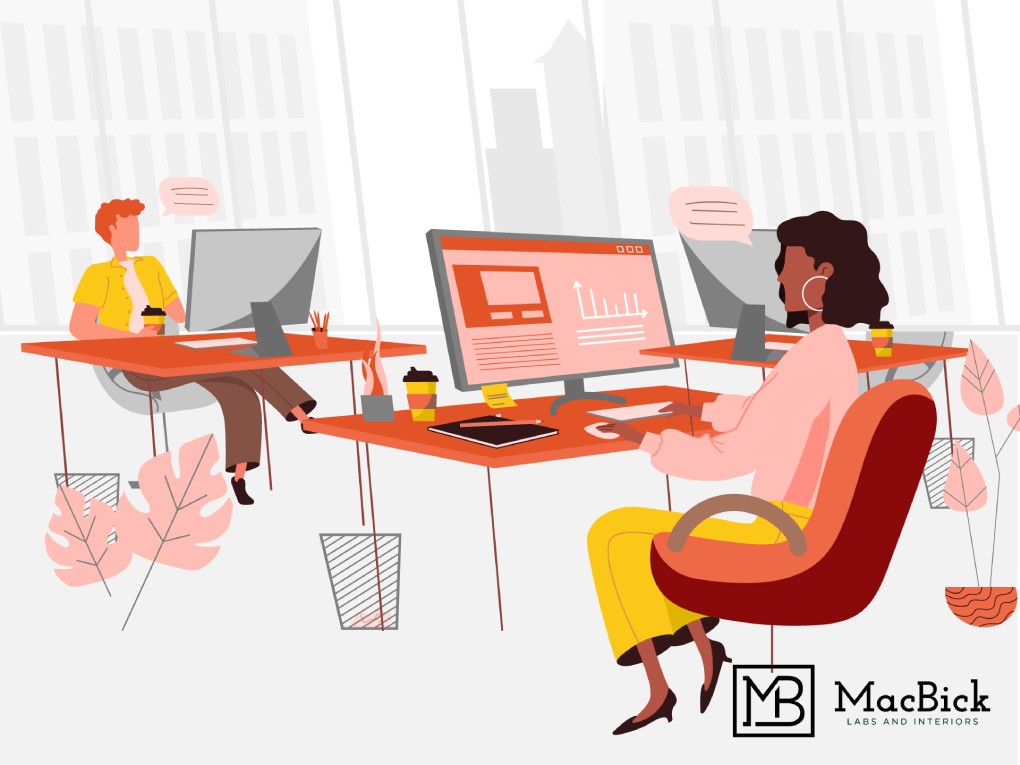Modern office layouts have undergone a profound transformation over the years. The office design and layout are no longer merely functional but are recognized as influential factors in enhancing employee productivity and well-being.
From ergonomic design elements to open-plan spaces, organizations have started investing in positive office layouts to promote the physical well-being of employees and foster collaboration.
Let’s take a closer look at the intricacies of the evolving office design landscape and uncover how embracing a positive office layout can foster a vibrant culture of innovation, engagement, and peak performance.
The Open Office Debate – Is It Good or Bad?
The open office concept is becoming more popular among business owners. The positive side of open office design is that it promotes communication and collaboration among team members. It increases employee knowledge and encourages them to work even harder.
However, it also has a lot of drawbacks. Open offices are large, shared workspaces without dividers or partitions. It can lead to increased noise levels and distractions, which can be a reason for low concentration in employees. It can be good for most of the employees, while some might face problems in open office design.
Effect of Ergonomics
Ergonomics is a vital part of a good work environment. It includes designing spaces and tools to fit the human body and plays a crucial role in employee well-being. An ergonomic office setup can reduce the risk of physical discomfort and feeling demotivated. It brings a feeling of satisfaction, leading to increased productivity and satisfaction.
Businesses should invest in adjustable chairs, sit-stand desks, and proper keyboard and monitor placement to create a positive workspace. Additionally, encouraging employees to take breaks and stretch throughout the day can further enhance their well-being.
Personalization and Flexibility
Personalization and flexibility in your office spaces are important to promote employee well-being. Allowing employees to personalize their workspaces with photos, plants, or artwork makes them happy. It creates a sense of ownership and comfort. Additionally, flexible office layouts and workstyles enable employees to choose the best environment for their specific needs.
Companies like Google have embraced flexible office design by offering a variety of workspaces and collaborative areas for team meetings and brainstorming sessions. This approach empowers employees to make choices that optimize their productivity.
Biophilic Design and Wellness Spaces
Biophilic office designs are popular for their positive impact on employee well-being. It incorporates natural elements and greenery into office environments, which creates a fresh working aura. Research has shown that exposure to natural elements can reduce stress and enhance one’s productivity.
Adding plants, natural light, and water features into your office can improve air and create a more pleasant work atmosphere. You can also take this concept further by adding wellness spaces for your employees. Make these spaces accessible where everyone can relax, meditate, or engage in physical activities to recharge themselves.
Noise Control and Privacy
Noise levels in the workplace can have a substantial impact on employee concentration and overall well-being. Excessive noise can lead to reduced productivity. Consider sound-absorbing materials, designated quiet zones, and noise-cancelling headphones for employees to address this issue.
Privacy is equally important in office design. While open offices promote collaboration, employees also need private spaces for focused work and confidential meetings. Incorporating phone booths or small meeting rooms can provide employees with the privacy they need when required.
Case Studies
To illustrate the real-world impact of office layout on employee productivity and well-being, let’s explore a few case studies.
Slack’s Redesigned Office
Slack is a popular messaging platform. The Slack team redesigned its office space to prioritize flexibility and well-being of everyone. The new Slack office layout includes a variety of workspaces. As a result, Slack reported an increase in employee satisfaction.
Microsoft’s Treehouse Meeting Rooms
Another example of innovative office designs is Microsoft’s Redmond campus. It features treehouse meeting rooms for a more creative approach. These unique spaces provide a serene and nature-inspired environment for meetings and creative brainstorming sessions.
Common Office Design Mistakes to Avoid:
As we know, office designs play a significant role in employees’ well-being. You can’t expect high productivity from your employees if their mental or physical health is not good. Here are some practical tips for businesses looking to optimize their office layouts:
Lack of Natural Light:
Pay attention to an adequate amount of natural light in your office. Natural light can boost mood, reduce eyestrain, and enhance productivity. Use large windows, glass partitions, and open spaces to maximize natural light throughout the workspace.
Poor Ergonomics:
Make sure the furniture and tools you are using in your office design are comfortable. Invest in ergonomic chairs, adjustable desks, and proper computer monitor positioning to prevent physical discomfort and long-term health issues.
Overcrowding:
Avoid cramming too many employees into a limited space. Overcrowded workspaces can lead to distractions, reduced focus, and increased stress. Provide enough space for employees to move around comfortably and maintain physical distancing, if necessary.
Lack of Privacy:
Provide options for private and semi-private workspaces for employees who need to concentrate or have sensitive discussions. Balance open collaboration areas with quiet spaces for individual work.
Inadequate Break Areas:
Pay attention to the importance of well-designed breaks and relaxation areas. Provide comfortable seating, natural elements, and amenities like coffee machines and kitchenettes to encourage employees to take breaks and recharge.
Poor Air Quality:
Ensure the workspace has proper HVAC systems and air purification measures in place to maintain a clean and healthy indoor environment.
Monotonous Design:
Incorporate biophilic design elements like plants and natural materials to create a visually appealing and calming workspace. Use various colors and textures to make the environment more engaging and avoid monotonous design.
Poor Lighting:
Avoid harsh or inadequate lighting, leading to eye strain and fatigue. Use a mix of lighting sources, including adjustable task lighting, to provide proper illumination for various tasks and employee preferences.
Neglecting Technology:
Don’t use outdated or unreliable technology. Invest in the latest office technology and ensure it’s user-friendly and well-maintained to support employee productivity.
Lack of Personalization:
Never use a stone approach to office design. Let employees personalize their workstations with photos, artwork, or other personal items to create a sense of ownership and comfort.
Never Ignore Employee Feedback:
Remember that you are creating the office for employees. So, make sure to gather feedback from your employees to understand their needs and preferences regarding office design.
Conclusion
Now you know the connection between a good office design and employee well-being. By considering all the essential needs of your workforce and incorporating positive elements, you can create a positive work environment where. As companies continue to evolve, they should recognize that a well-designed office is an investment in the success and well-being of their most valuable asset: their employees.
Get in touch with MacBick for the most reliable office design services.



